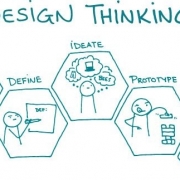The Importance of Design Thinking in All Things
We know that “design thinking” is responsible for the big disruptions that have occurred in the past decade (Apple, Google, NIKE, Air-b-and-b, UBER, etc.). But, what is design thinking?
Design Thinking is a methodology used by designers to solve complex problems and find desirable solutions for clients.
A design mindset is not problem-focused, however; it’s solution focused, and action oriented towards creating a preferred future.
Design Thinking draws upon logic, imagination, intuition, and systemic reasoning, to explore possibilities of what could be—and to create desired outcomes that benefit the end user (the customer).
Design thinking can be described as a discipline that uses the designer’s sensibility and methods to match people’s needs with what is technologically feasible and what a viable business strategy can convert into customer value and market opportunity.
Design is the action of bringing something new and desired into existence—a proactive stance that resolves or dissolves problematic situations by design. It is a compound of routine, adaptive and design expertise brought to bear on complex dynamic situations.
In his 2007 book, Designerly Ways of Knowing, Nigel Cross asserts that “Everything we have around us has been designed.” Design ability is, in fact, one of the three fundamental dimensions of human intelligence.
Design, Science, and Art (a trifecta) form an “AND” not an “OR” relationship to create the incredible human cognitive ability.” Simply put:
· Science — finding similarities among things that are different
· Art — finding differences among things that are similar
· Design — creating feasible ‘wholes’ from infeasible ‘parts’
It makes sense, therefore, to break out of the silos we have created in organizations and develop a cross-disciplinary inquiry to foster innovation.
To break out of the silos and think like a designer, I recommend using the SCAMPER approach, which is an acronym for: Substitute, Combine, Adapt, Modify, Put to Other Use, Eliminate, or Reverse or Rearrange.
When you think about your daily tasks at work, or indeed think about your work at a higher level about your organization’s goals and modus operandi, is there any part of that that couldn’t benefit from being subjected to a new fresh look by asking the SCAMPER questions?
Let’s keep this conversation going…




